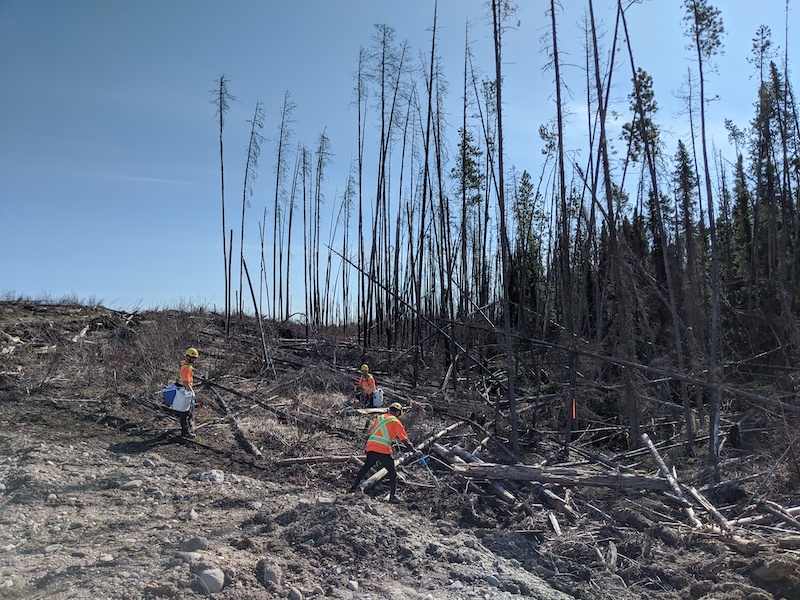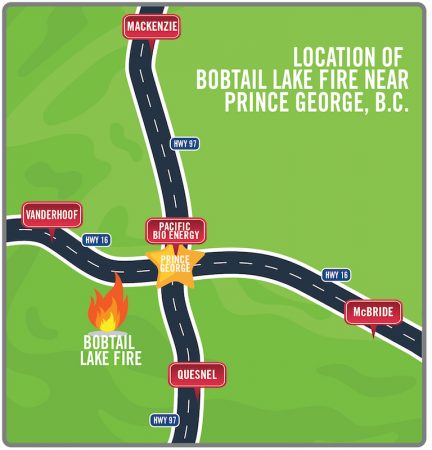
Pacific Bioenergy leads the way with salvage and reforestation program
June 1, 2020
By Gordon Murray, WPAC
 Photo courtesy Pacific BioEnergy.
Photo courtesy Pacific BioEnergy. Pacific Bioenergy’s (PacBio) salvage and reforestation program is demonstrating the important contribution that a strong, competitive bioenergy sector can make in advancing sustainable forest management and contributing to a low-carbon economy.
In 2015, the Bobtail Lake fire burned more than 25,000 hectares of land west of Prince George, B.C. While the fire-damaged trees that remain standing after a fire moves through an area can sometimes be salvaged by sawmills and converted into lumber, in this instance the burning and charring was so severe that they could not be used for this purpose.
Before the arrival of the wood pellet sector, the burned trees from the Bobtail Lake fire would have been left to decay over many years, slowly emitting carbon to the atmosphere and wasting this valuable resource. Fortunately, PacBio saw an opportunity to salvage fibre from this area to make wood pellets, creating a valuable product and providing jobs while at the same time opening up the fire area for reforestation activities to restore a healthy forest to this burned landscape.
In 2019, PacBio began salvage harvesting on a 2,250-hectare area in the Bobtail, which represents the first time in British Columbia that a bioenergy licence has been used for large-scale salvage. Harvesting operations went smoothly, with fibre trucked to PacBio’s Prince George facility for processing – but just as reforestation activities were set to start up, the COVID-19 pandemic arrived, and PacBio was faced with either completely redesigning their silviculture plans or abandoning the planting season for 2020.
Partnering with local contractors Freya Logging and Strategic Natural Resource Consultants, PacBio developed a plan that would utilize local contractors for reforestation rather than relying on camp crews of tree planters who travel across the province for silviculture contracts. This model employed local forest workers who were idled because of COVID-19, contributing to the local economy while also improving safety planning related to the virus epidemic. On May 8, the first of 1.1 million seedlings were planted by PacBio in the Bobtail and the reforestation is expected to be completed by early July.
“PacBio’s innovative fibre supply strategies focuses on harvest residuals which would have been ‘piled and burned’ such as low-quality, beetle-killed, and deciduous logs that the sawmills and pulp and paper mills can’t use,” says PacBio CEO John Stirling. “Our ability to access this material has allowed us to supplement our fibre supply and keep our Prince George plant operating, and to help advance reforestation of this area that was devastated by the 2015 wildfire.”
By utilizing this fibre and reforesting the Bobtail burn area, PacBio is actively restoring this fire-damaged area into a healthy new forest that instead of emitting carbon will now be acting as a carbon sink by absorbing CO2 from the atmosphere as the trees grow. Moreover, PacBio will ship its wood pellets to electric power plants in Europe and Asia where they will be used as a clean, renewable alternative to coal, providing even more climate benefits.
This salvage program and reforestation effort demonstrates the critical role for bioenergy production in a sustainable forest sector – improving responsible utilization of forest fibre to create green products, local jobs and strong environmental outcomes on the ground and for global customers.
Gordon Murray is the executive director of the Wood Pellet Association of Canada (WPAC).
Print this page
